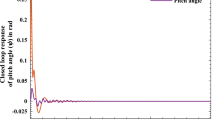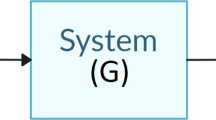Abstract
This paper investigates the asymptotical stabilization of port-controlled Hamiltonian (PCH) systems via the improved potential energy-shaping (IPES) method. First, a desired potential energy introduced by a transitive Hamiltonian function is added to the original kinetic energy to yield a desired Hamiltonian function. Second, an asymptotically stabilized controller is designed based on a new matching equation with the obtained Hamiltonian function. Finally, a numerical example is given to show the effectiveness of the proposed method.
Similar content being viewed by others
References
M. Dalsmo, A. van der Schaft. On representations and integrability of mathematical structreus in energy-consverving physical systems. SIAM Journal on Control and Optimization, 1998, 37(1): 54–91.
A. van der Schaft. L 2-Gain and Passivity Techniques in the Nonlinear Control. London: Springer, 2000.
R. Ortega, A. van der Schaft, B. Maschke, et al. Interconnection and damping assignment passivity-based control of port-controlled Hamiltonian systems. Automatica, 2002, 38(4): 585–596.
R. Ortega, E. Garcia-Canseco. Interconnection and damping assignment passivity-based control: A survey. European Journal of Control, 2004, 10(2): 432–450.
R. Ortega, A. van der Schaft, F. Castanos, et al. Control by interconnection and standard passivity-based control of Port- Hamiltonian systems. IEEE Transations on Automatic Control, 2008, 53(11): 2527–2542.
F. Castanos, R. Ortega. Energy-balancing passivity-based control is equivalent to disspation and output invariance. Systems & Control Letters, 2009, 58(8): 533–560.
A. Donaire, S. Junco. Energy shaping, interconnection and damping assignmeng, and intergral control in the bond graph domain. Simulation Modelling Practice and Theory, 2009, 17(2): 152–174.
R. Ortega, M. W. Spong, F. Gomez-estern, et al. Stabilization of a class of underactuated mechanical systems via interconnection and damping assignment. IEEE Transactions on Automatic Control, 2002, 47(8): 1218–1233.
A. Doria-Cerezo. Modeling, Simulation and Control of a Doublyfed Induction Machine Controlled by a Back-to-back Converter. Universitat Politecnica de Catalunya, 2006.
F. Castanos, R. Ortega, A. van der Schaft, et al. Asymptotic stabilization via control by interconnection of port-Hamiltonian systems. Automatica, 2009, 45(7): 1611–1618.
A. Donaire, S. Junco. On the addition of integral action to portcontrolled Hamiltonian systems. Automatica, 2009, 45(8): 1910–1916.
A. Astolfi, R. Ortega, A. Venkatraman. A globally exponentially convergent immersion and invariance speed observer for machanical systems with nonholomic constraints. Automatica, 2010, 46(1): 182–189.
A. Venkatraman, R. Ortega, I. Sarras, et al. Speed observation and position feedback stabilization of partially lineariable mechanical systems. IEEE Transcations on Automatic Control, 2010, 55(5): 1059–1074.
D. Jeltsema, R. Ortega, J. M. A. Scherpen. An energy-balancing perspective of interconnection and damping assignmen control of nonlinear systems. Automatica, 2004, 40(9): 1643–1646.
H. Ramire, D. Sbarbaro, R. Ortega. On the control of non-linear processes: An IDA-PBC approach. Journal of Process Control, 2009, 19(3): 405–414.
Z. Xi, D. Cheng. Passivity-based stabilization and H∞ control of the Hamiltonian control systems with dissipation and its applications to power systems. International Journal of Control, 2000, 73(18): 1686–1691.
Author information
Authors and Affiliations
Corresponding author
Additional information
This work was partly supported by the National Natural Science Foundation of China (Nos. 61125301, 60974026).
Liangcheng CAI is a Ph.D. candidate in the Central South University, Changsha, China. His research interests are nonlinear control and Hamiltonian system control.
Yong HE received his B.S. and M.S. degrees, in Applied Mathematics from Central South University, Changsha, China in 1991 and 1994, respectively. He received his Ph.D. degree in Control Theory and Control Engineering from Central South University in 2004. He received the Guan Zhao-Zhi Award of the 26th Chinese Control Conference in 2007 (jointly with M. Wu, G. Liu and J. She). Currently, he is a professor in Central South University and his research interests are time-delay system control, robust control and network control.
Min WU received his B.S. and M.S. degrees in Engineering from Central South University, Changsha, China, in 1983 and 1986, respectively, and the Ph.D. degree in Engineering from Tokyo Institute of Technology, Tokyo, Japan, in 1999. He received the IFAC Control Engineering Practice Prize Paper Award in 1999 (together with M. Nakano and J. She). Currently, he is a professor in Central South University and his research interests are process control, robust control, and intelligent system.
Jinhua SHE received his B.S. degree in Engineering from Central South University, Changsha, China in 1983, and the M.S. and Ph.D. degrees in Engineering from Tokyo Institute of Technology, Tokyo, Japan, in 1990 and 1993, respectively. He received the IFAC Control Engineering Practice Paper Prize in 1999 (jointly with M. Wu and M. Nakano). Currently, he is a professor in Tokyo University of Technology and his research interests are robust control and repetitive control.
Rights and permissions
About this article
Cite this article
Cai, L., He, Y., Wu, M. et al. Improved potential energy-shaping for port-controlled Hamiltonian systems. J. Control Theory Appl. 10, 385–390 (2012). https://doi.org/10.1007/s11768-012-0282-9
Received:
Revised:
Published:
Issue Date:
DOI: https://doi.org/10.1007/s11768-012-0282-9




